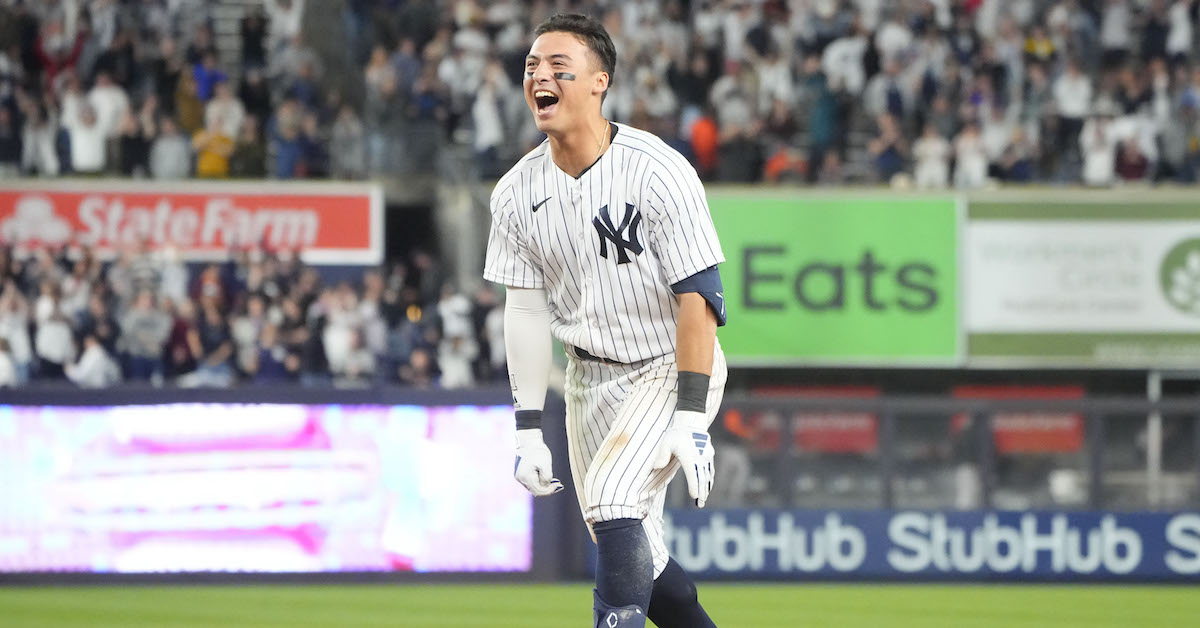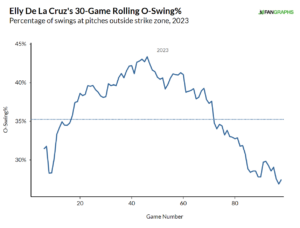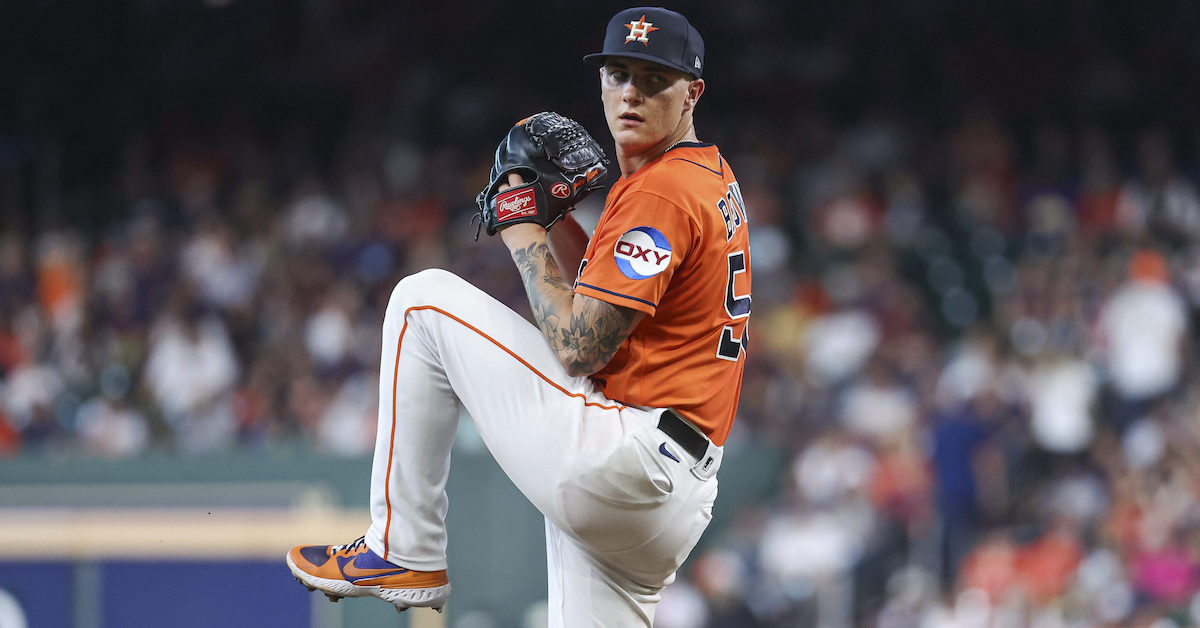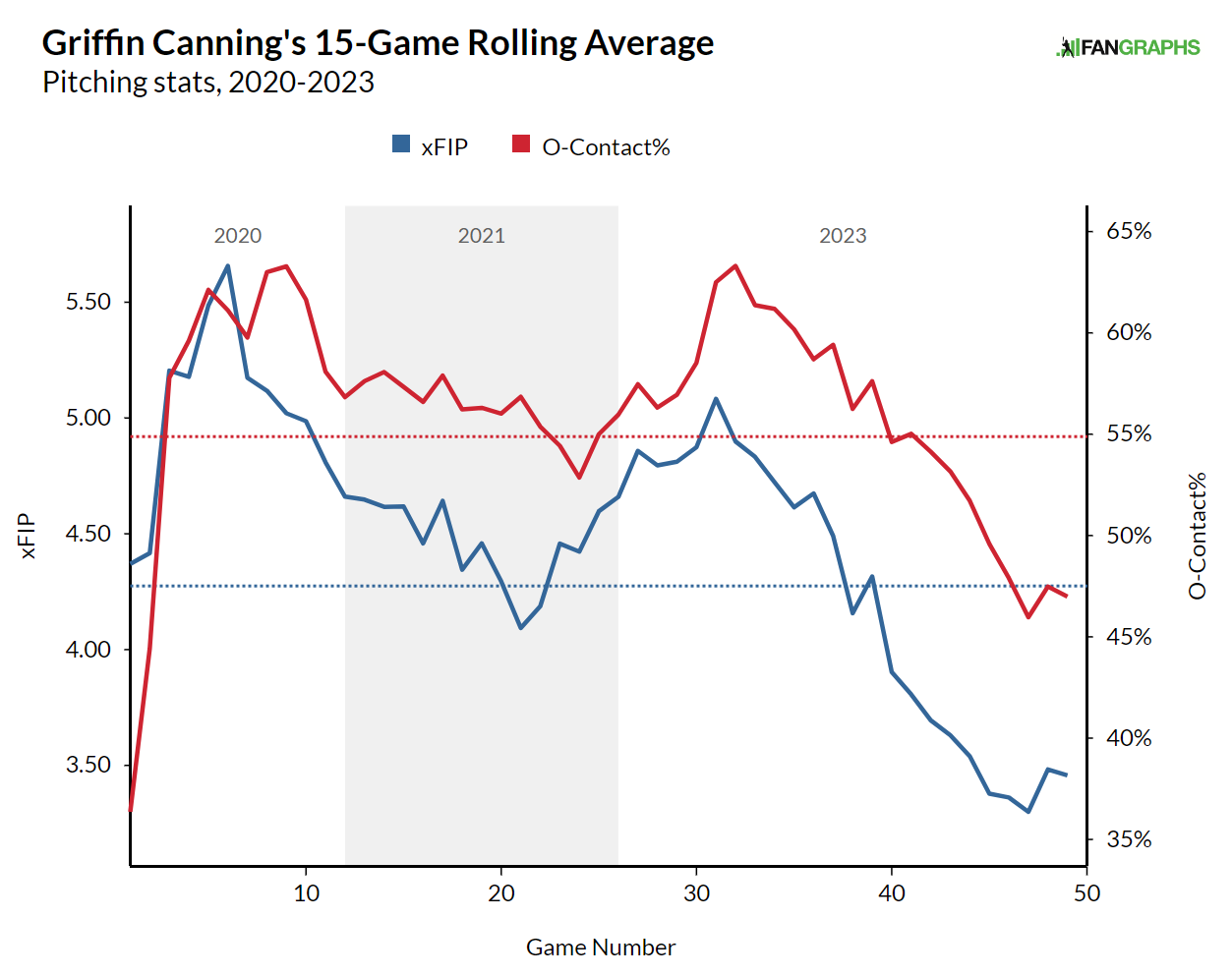Szymborski’s 2024 Booms and Busts: Hitters

With the start of the season just two weeks away, it’s time for one of my most beloved/hated/dreaded annual traditions: making my picks for breakouts and busts. For those of you who haven’t read one of these pieces in the past, these are my picks for the players who are the most likely to change the general consensus about them over the course of the 2024 season. And since we’re talking about generally low-probability outcomes — this isn’t a list of players with better or worse projections than last year — there’s no exercise with more potential to make me look super smart… or dumb. For every J.P. Crawford or Steven Kwan triumph, there’s an instance of Andrew Vaughn-induced shame.
As usual, let’s start with a quick table of the triumphs and humiliations of last year’s picks:
| Player | BA | OBP | SLG | wRC+ | WAR |
|---|---|---|---|---|---|
| Bryson Stott | .280 | .329 | .419 | 101 | 3.9 |
| Gleyber Torres | .273 | .347 | .453 | 123 | 3.2 |
| Seiya Suzuki | .285 | .357 | .485 | 126 | 3.2 |
| Oneil Cruz | .250 | .375 | .375 | 109 | 0.3 |
| Jesús Sánchez | .253 | .327 | .450 | 109 | 1.3 |
| Jordan Walker | .276 | .342 | .445 | 116 | 0.2 |
| Riley Greene | .288 | .349 | .447 | 119 | 2.3 |
| Andrew Vaughn | .258 | .314 | .429 | 103 | 0.3 |
| Player | BA | OBP | SLG | wRC+ | WAR |
|---|---|---|---|---|---|
| Paul Goldschmidt | .268 | .363 | .447 | 122 | 3.7 |
| Joey Gallo | .177 | .301 | .440 | 104 | 0.7 |
| Nick Castellanos | .272 | .311 | .476 | 109 | 1.0 |
| Yasmani Grandal | .234 | .309 | .339 | 80 | -0.1 |
| C.J. Cron | .248 | .295 | .434 | 82 | -0.5 |
| Josh Donaldson | .152 | .249 | .418 | 78 | 0.0 |
| Salvador Perez | .255 | .292 | .422 | 86 | -0.3 |
| Christian Walker | .258 | .333 | .497 | 120 | 3.8 |
It was about an average year. Vaughn and Christian Walker were the biggest misses, and Jordan Walker’s lousy defense kept him from being a win. Now on to this year’s picks.
The Breakouts
Spencer Torkelson, Detroit Tigers
Spencer Torkelson’s .233/.313/.446 line certainly didn’t knock any socks off, but he was a (relative) beast over the last two months of the season, hitting .244/.329/.526 with 16 homers. Now, I always warn folks to not read too much into monthly splits because there’s a tendency to think that splits coinciding with a good explanation are enough to overcome the small sample size issues, and because the endpoints are selective. The two-month split, however, isn’t why Torkelson’s here. Rather, there was a lot of evidence to suggest that he was underperforming his peripherals for most of the season up until that point. From the beginning of the season through August 8, Torkelson was the biggest zStats underachiever with significant playing time. Using only Statcast data with no information as to actual results, ZiPS thought that in that span Tork should have been an .868 OPS hitter; his actual OPS was .688. His OPS after that day? .921! Remember, Torkelson was a top-five prospect in baseball entering his rookie season in 2022, so even though his first year was a disaster, he’s not some 31-year-old beer leaguer coming out of nowhere.
Patrick Bailey’s Bat, San Francisco Giants
I can’t really call it a full breakout since Patrick Bailey already had an overall breakout season, thanks to defense that crushed even the loftiest of expectations. What puts him here is that people may be sleeping on his bat. No, I don’t think there’s any chance he starts hitting like Buster Posey, but Bailey’s otherworldly defense and lackluster bat (wRC+ of 78) appears to have pigeonholed him as a typical no-hit, all-glove backstop. I think that would be a mistake. Catchers have really weird developmental curves and I can’t stress enough how difficult it is for a catcher to nearly skip the high minors; he only played 28 games above A-ball before debuting in San Francisco. He hit .251/.351/.424 in the minors – again, not star quality but far from a total zero – and even without full developmental time offensively, he wasn’t completely destroyed by MLB pitching. In fact, he showed surprisingly solid plate discipline and power for a prospect with so little experience with the bat. Both ZiPS and our Depth Charts project Bailey to have an 82 wRC+, but I would not be shocked if he finished the season with a mark between 95 and 100, which, if his defense holds up, would make him an elite catcher overall.
Wyatt Langford, Texas Rangers
I don’t have a formal rule about it, but when ZiPS projects a player with little or no MLB experience to lead in a significant stat, I should take it very seriously since ZiPS doesn’t often go nuts about minor leaguers. The last player I can think of is Luis Arraez, who had a 21% chance of hitting .300 for his rookie season, according to ZiPS, which also projected him to have the highest batting average in baseball by 2020. ZiPS thinks Wyatt Langford is going to lead the majors in doubles and be one of the best offensive rookies in recent years. He was one of the few college hitters that ZiPS saw as nearly ready for the majors in 2023, and it liked him more than similarly advanced hitters Nolan Schanuel and Dylan Crews. Since ZiPS is my sidekick – or maybe it’s the other way around – I gotta have its back!
Anthony Volpe, New York Yankees
Anthony Volpe had a solid rookie season, but given his elite prospect status, it was a mild disappointment that he was only league average. Because of this, I think people are now underselling his offensive upside. He hit for a lot of power for a 22-year-old shortstop (21 home runs, .174 ISO). He also stole 24 bases on 29 tries, including successfully swiping each of his first 15 attempts, and was worth 3.5 base running runs. Two of his biggest problems were that he didn’t get on base enough (.283 OBP, 8.7 BB%) and struck out too much (27.8 K%), but these weren’t issues for him in the minors, and some of his fundamentals here are promising — he actually gets off to fewer 0-1 counts than most players with his strikeout rate. All of this suggests that he should figure things out with more major league experience. ZiPS also thinks he should have had a .312 BABIP given his Statcast data, instead of his actual mark of .259, which indicates that some of his woes were likely do to bad luck.
Keibert Ruiz, Washington Nationals
As with Volpe, I think Keibert Ruiz’s low BABIP, especially his .223 BABIP in the first half, made his season look a lot weaker than it was. ZiPS saw a .270 BABIP as a more reasonable number for him as a hitter in the first half, and that number continued to rise in the second half; he had a .285 zBABIP by the end of the season. Giving Ruiz back some of the batting average makes his actual .226/.279/.360 first-half line look a lot less abysmal and his .300/.342/.467 one in the second half look less like a fluke. In fact, except for a bit more power, most of the difference between his first half and second half was BABIP, so the halves weren’t quite as different as they appeared. Overall, his zStats line of .274/.330/.445 reflects a much more advanced hitter than we saw overall in 2023.
As I reminded people with Bailey, catchers tend to have a weird developmental pattern, and Ruiz has been no exception. Ruiz was a top prospect for a long time before hitting the Double-A wall, and his standing fell quite a bit in the eyes of prospect watchers. But he re-established himself as a top prospect to a degree that he was a huge part of Washington’s return when it traded Max Scherzer and Trea Turner to the Dodgers in 2021. I think people forget how young he still is at 25, and being older is not as big of a deal for a catching prospect than for someone at any other position.
Elly De La Cruz, Cincinnati Reds
Elly De La Cruz is a common breakout pick for obvious reasons, but I’m including him here specifically because his plate discipline wasn’t as bad as it looks from the raw stats. ZiPS actually thought, from his plate discipline data, that his strikeout rate should have been more like 27% instead of nearly 34%, enough to knock off 27 strikeouts. And given that he should be a high BABIP player, because he was the fastest man in baseball last year, putting more balls in play would benefit him more than it would most players. Overall, his zStats line last year was .273/.323/.449, compared to his actual line of .235/.300/.410, meaning the holes in his game aren’t quite as deep as his reputation would suggest.
And if you don’t buy that, he did show better plate discipline as the season progressed. I’ll again warn of the dangers of storylines that coincide with splits, but things like offensive swing percentage stabilize very quickly, mitigating some of the sample size issues. I don’t think it’s a stretch to look at the graph below and conclude that De La Cruz got caught up in the hype of his initial success and became too aggressive. As a result, he started struggling before coming to realize that he had gotten away from the approach that made him such a dynamic player in the first place.

Dominic Canzone, Seattle Mariners
One should be suspicious of Pacific Coast League stats, but Dominic Canzone’s .354/.431/.634 line last year was good even by PCL standards, enough for a 151 wRC+ in the league. However, that success didn’t follow him to the majors. He probably doesn’t have a lot of upside, but the rate of his improvement over the last couple of years suggests that there’s a chance he could have a nice little Geronimo Berroa-esque run.
Tucupita Marcano, San Diego Padres
This one is kind of a stretch because I don’t see an obvious path for Tucupita Marcano to get much playing time. He hasn’t hit at all in the majors yet, but he’s also had a weird minor league career; he’s still just coming off his age-23 season and has made some progress at translating his minor league plate discipline to the majors. ZiPS isn’t in on him, but Steamer is, and if he can managed his 94 wRC+ Steamer projection, along with a decent glove (though more at second base than short) and his speed, he’ll at least be interesting. Gotta have one out there pick, no?
The Busts
Cody Bellinger, Chicago Cubs
I don’t think Cody Bellinger will fall anywhere near the depths of his brutal 2021 season, but there are reasons to be suspicious of last year’s resurgence. He changed some of his mechanics and altered his approach, especially in two-strike counts, to make more contact, and those adjustments should be sustainable. It’s the power numbers that are a bit preposterous, to the degree I can’t think of any comparable player who managed to maintain this amount of power with mediocre-at-best exit velocity numbers. Statcast’s expected slugging percentage knocks 88 points off his actual one, and the ZiPS version (zSLG) is 20 points meaner than that.
J.T. Realmuto, Philadelphia Phillies
This one hurts, especially for a player ZiPS was so excited about in 2015-2016 before his breakout. But the decline in J.T. Realmuto’s offensive numbers in 2023 is supported by the drop in his peripheral numbers; he was just a bit worse at everything last year. He’s also a catcher entering his mid 30s. This is a gut thing more than a projection thing, but I suspect any kind of a leg injury would be a bigger deal for a surprisingly quick player like Realmuto, whose offensive stats already reflect his speed, than for your typical catcher.
Isaac Paredes, Tampa Bay Rays
Isaac Paredes is a good hitter, but is he really a 140 wRC+ guy? In both Statcast and ZiPS, Paredes had an even larger disparity between his actual power numbers and his peripherals than Bellinger. That said, there’s some good news, because unlike Bellinger, Paredes has done this before. There were 20 hitters in 2022 that hit at least five more homers than zHR expected, and 18 of them went on to hit fewer home runs in 2023. Paredes was one of the two who hit more (the other was Pete Alonso). Because Paredes has such a low hard-hit percentage, I’m not completely on board yet.
Lane Thomas, Washington Nationals
One thing about Cinderella stories is that people tend to overrate them after the ball. Most of these stories don’t involve permanent stardom; Joey Meneses and Frank Schwindel are two example of people getting too excited about an older breakout guy. Unlike Schwindel, Lane Thomas is probably still a league-average player, on the level of his 2021 and 2022 seasons, but I’d be shocked to see him hit 30 homers again. He’s probably a stopgap center fielder/fourth outfielder type, and I’m seeing him surprisingly high in some fantasy rankings.
Dominic Fletcher, Chicago White Sox
I was pretty shocked to see the White Sox trade Cristian Mena for Dominic Fletcher, even with the assumption that ZiPS is being too exuberant about Mena in ranking him at the back of the top 50 prospects. If you evaluate him the way our prospect team does, a fourth outfielder for a 45 FV prospect is quite a rich gain. And it’s looking like the Sox will give Fletcher a pretty good chance at getting the majority of the playing time in right field. It’s not as bad as the team’s irrational excitement about Oscar Colás last year, but there’s just not a lot of support for Fletcher’s maintaining his .301/.350/.441 line from his brief stint in the majors. That’s ridiculously higher than his zStats slash line of .249/.290/.376, which works out to a difference of 125 OPS points.










